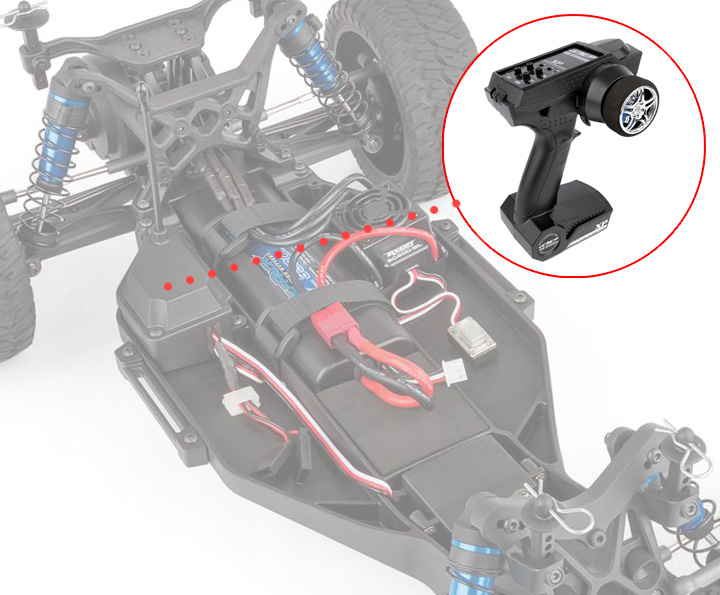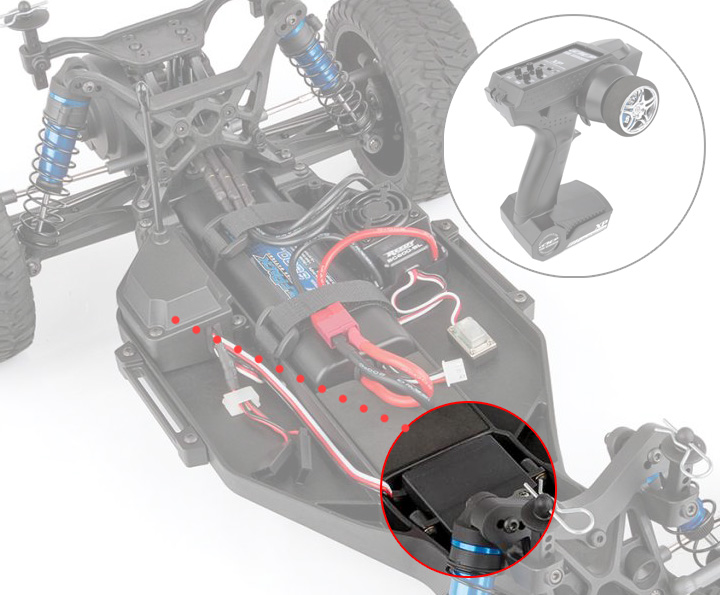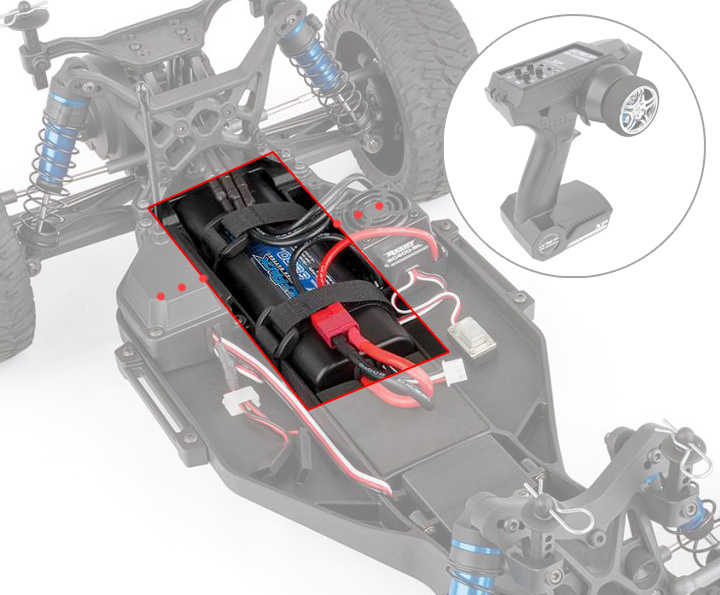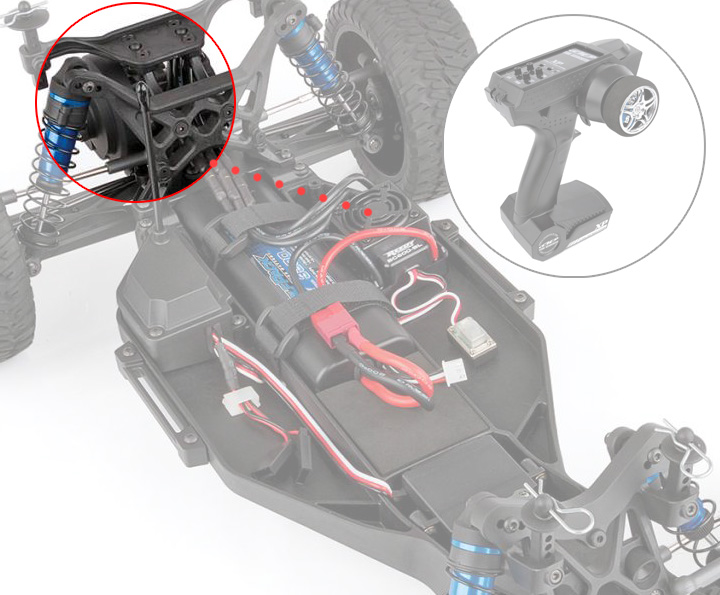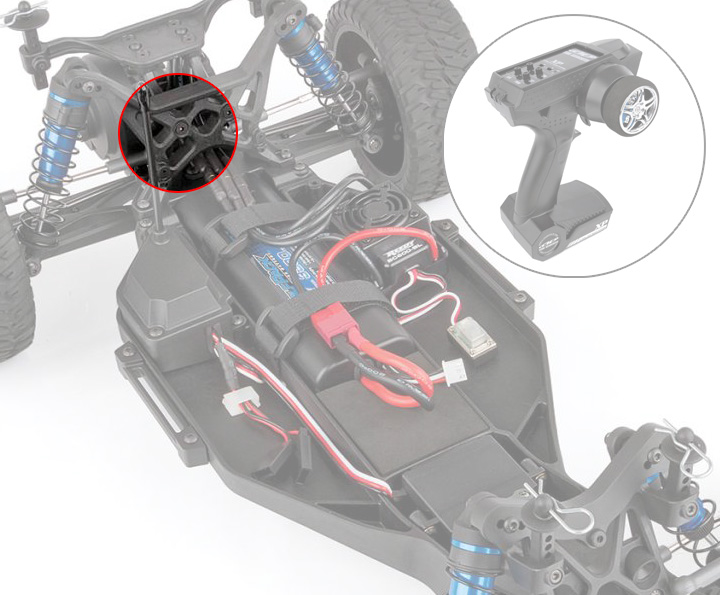Newcomer's Guide to Radio-Controlled Cars and Trucks
Welcome to the world of radio-controlled (RC) car racing! RC cars have enjoyed worldwide popularity and are available on every continent. RC racing cars and trucks differ from the toy store variety in many exciting ways. Built for toughness, competition, speed, and handling, they utilize advanced manufacturing processes to withstand the many jumps and bumps of competition racing. Their components are configurable, just like the real race cars. You can change the oil, shock springs, caster, camber, and many other features of the cars in order to get the best setup for racing.
You control the RC racing vehicle's speed and steering by a hand-held radio transmitter. The cars and trucks are powered by either an electric motor or nitro-powered engine.
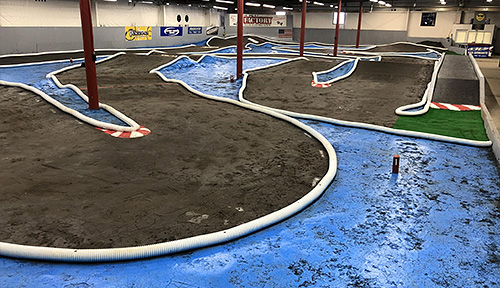
CRCRC RC track in Ohio
Prepared tracks have been erected to provide a place to practice and race. Tracks come with different surfaces to accommodate the many types of cars and trucks, such as asphalt, AstroTurf™, or a dirt/clay mixture.
Several governing bodies, such as ROAR (Radio Operated Auto Racing) and IFMAR (International Federation of Model Auto Racing), serve the hobby and provide rules and consistency from race to race. The most important Nationals and World Championships are governed by rules from these organizations and attract the world's best racers, providing the most exciting racing you can watch. Separate National and World Championships are held for the various scales in onroad and offroad vehicles. Local, national, and international races are held, the larger races drawing hundreds of racers worldwide to compete or learn from the best racers. Team Associated boasts the most IFMAR World Championship wins among all RC manufacturers.
RC clubs provide a place for fellow racers to compete, swap tips, and find friends. RC car news sites help provide direction on everything from tuning tips, parts releases, kit reviews, and race schedules.
The following pages were designed to help you understand the RC race car hobby and its vehicles with the hope that you will be a more informed consumer of this most exciting hobby! Our polled customers explained why they prefer Team Associated vehicles the most:
- Our kits are competitive right out of the box
- Spare parts are available everywhere
- Competitive pricing
- Superior workmanship and durability
- Easy to assemble
- FUN, FUN, FUN!
How Fast Does It Go?
We understand the desire to go fast! However, when racing, it's not how fast you go, but how well you drive around the track that wins the race. Beginners never really get up to the fastest speed possible -- there's always another turn to slow down for, obstacle to avoid, buddy's car to drive around, or a jump to make. Being able to drive consistently is more important for the beginner. When you stop crashing, you will find that you start going faster. And if you want even more power then look into getting a faster motor, or just work on the gearing and setup to get better performance from the equipment that you have. Team Associated vehicles run at speeds that give you good control of your vehicle. We recommend that if minors are under 14 that they have adult supervision.
How Much Does It Cost?
How much do you want to spend? In general, prices start around $200 for basic 1:12 electric car RTRs and up for fully-loaded 1:8 nitro offroad kits, not including the radio equipment, motor/engine and batteries/fuel. As with real racing, serious racers easily quadruple their costs by purchasing multiples of everything so they will have productive pit stops. There's a model for every budget, so there's no need to put off your involvement in one of the most exciting and rewarding hobbies ever!
Where Do I Race?
What's a race car without a track? Some tracks are simple dirt layouts on vacant dirt lots. More sophisticated tracks include lap counters, pit area, restrooms, a store, challenging track layout, and sturdy track barriers. Tracks come with different surfaces to accommodate the many types of cars and trucks - dirt, clay, and AstroTurf™ for offroad vehicles; and carpet, paved, and cement for onroad vehicles. RC clubs provide a place for fellow racers to compete, swap tips, and find friends. RC car magazines, apps, and online sites help provide direction on everything from tuning tips, kit reviews, race schedules, to locations of clubs and race tracks. Watch some sample races here! Look for a track near you here.
What type of radio-controlled car is best for beginners?
For beginners, it's recommended to start with a basic, easy-to-use, and affordable radio-controlled car that is durable and easy to control. Here are some types of RC cars that are good for beginners:
Electric Ready-to-Run (RTR) cars: These are pre-assembled and usually come with everything you need to get started, including a battery, charger, and radio. They are easy to use and require little to no maintenance.
Offroad buggies and trucks: These are great for beginners as they are durable, easy to control, and are built to handle a variety of terrain, especially trucks. They typically have larger wheels and suspension systems than onroad that make them ideal for offroad use.
Onroad cars: These are designed for use on smooth surfaces such as asphalt streets, concrete, and carpet tracks. They are generally faster and more challenging to control than off-road cars, but can still be a good option for beginners if they are geared properly at slower speeds.
Monster trucks: These are larger and more rugged than other types of RC cars, making them great for beginners who want to tackle more challenging terrains.
Crawlers and trail trucks: These trucks are built for tough terrain and easy speeds, and are great for beginners. Beginners especially love their scale looks.
Overall, the best type of radio-controlled car for beginners depends on personal preferences and the intended use. It's important to choose a car that is easy to control and maintain, durable, and within your budget. It's also recommended to start with a slower speed and gradually work your way up to faster and more advanced electronics as you gain more experience.
What kind of batteries do I need for my radio-controlled car?
Radio-controlled cars typically use rechargeable Lithium polymer (LiPo) or nickel-metal hydride (NiMH) batteries. These batteries provide a high power density and are able to deliver the high currents required by RC cars.
Lithium polymer batteries are known for their high energy density, light weight, and long lifespan. They are commonly used in high-end RC cars and provide longer run times compared to other types of batteries.
Nickel-metal hydride (NiMH) batteries are also a popular choice for RC cars, as they are affordable and offer good performance. They are available in various capacities and are compatible with a wide range of RC car models.
The capacity and physical dimensions of the battery are also important. Most batteries for 1:10 scale are standard-size "stick" 2S batteries, whether LiPo or NiMH. A few 1:10 high-end vehicles use "shorty" batteries; they are shorter than normal, as the name implies. 1:14 vehicles may use 2S batteries that are smaller in size and capacity than 4S batteries. Unfortunately, this information is not always apparent to the newcomer. Hobby shop staff will give help in this area.
1:10 scales generally are compatible with 2S LiPo or 6-cell NiMH batteries. Refer to your ESC manual for compatibility with the type of battery you use. Also refer the car's manual whether it can fit standard stick type battery or requires the small shorty pack design.
When you get a battery charger, make sure it will charge your type of battery, whether LiPo or NiMH. Few chargers will charge both types.
What kind of maintenance is required for a radio-controlled car?
RC cars require regular maintenance to ensure they operate properly and last a long time. Here are some maintenance tasks that are typically required for RC cars:
Cleaning: It's important to keep your RC car clean to prevent dirt and debris from getting into the moving parts and causing damage. Use a soft brush and damp cloth to clean the car and make sure to dry it thoroughly before using it again.
Lubrication: The moving parts of an RC car, such as the coupler that connects the axle to the CV bone, need to be lubricated regularly to prevent them from wearing out and causing damage. Use the fluid designed for RC cars to lubricate these parts.
Battery care: Follow the manufacturer's recommendations for charging and storing the batteries to ensure they last as long as possible. This is especially true for LiPo batteries, which need more care.
Tire maintenance: The tires on an RC car can wear out over time and affect its performance. Check the tires regularly for wear and replace them when necessary.
Suspension maintenance: The suspension system of an RC car should be checked regularly for damage and wear. Make sure the shocks and springs are functioning properly and adjust them as needed. Inspect all moving joints and clear them so they are free of debris.
Electronics maintenance: The electronics in an RC car, such as the motor and receiver, need to be checked regularly for damage and wear. Make sure all connections are secure and that the wires are not frayed or damaged.
Overall, regular maintenance is essential for keeping your RC car in good condition and ensuring it performs at its best. Follow the manufacturer's recommendations for maintenance and make sure to address any issues as soon as they arise to prevent further damage.
Are there any safety tips I should be aware of when using a radio-controlled car?
Yes, there are some safety tips to keep in mind when using an RC car to ensure that you and those around you stay safe. Here are some of the most important safety tips to keep in mind:
Always read and follow the manufacturer's instructions: Before using your RC car, make sure to read the manual's instructions carefully and follow them closely.
Use your RC car in a safe area: Choose an open area free from obstacles and people. Make sure the area is suitable for the type of car you are using.
Do not use your RC car near water: Avoid using your RC car near water or in wet conditions to avoid damage to your car and protect from electric shock. There are some exceptions, such as vehicles with coverings for their electronics.
Be aware of your surroundings: Keep an eye out for any obstacles or people in the area, and be aware of your surroundings at all times.
Respect others' privacy and property: Do not use your RC car on private property without permission. With noisy nitro-powered cars, be respectful of the time of day they are run.
Wear appropriate safety gear: Always wear appropriate safety gear, especially eye protection, when preparing your RC car for running. Nitro-powered vehicles require plenty of ventilation for preparation.
Keep your RC car in good condition: Regularly maintain and inspect your RC car to ensure that it is in good working condition. Check for loose parts, damaged components, or any other issues that could create dangerous conditions.
Remember the order of electronics: Always turn on the transmitter first and then the vehicle. And when finished, turn off the vehicle first and then the transmitter. This way, as long as you have the transmitter on, you'll always have control.
Pay attention to battery warnings: When you have finished driving your vehicle, be sure to unplug the battery and remove it from the vehicle. Do not charge the battery while it's still in the vehicle, and never leave a charging battery unattended. If you’re using a LiPo battery and have run the battery to the cutoff point, be sure to add some charge, perhaps 10 or 15 minutes, to the battery before you put it away. Remove the battery and store in a LiPo Sack or ammo can that you can get from an army surplus store.
By following these safety tips, you can enjoy using your RC car safely, and prevent accidents or damage to yourself, others, or property.
What does "AE" stand for?
AE stands for the legal name of our company, Associated Electrics. We call ourselves Team Associated to emphasize the race aspect of our products. To learn more about Team Associated, visit here and click on "About Us" in the left menu for a general overview, "Brands" to familiarize yourself with our different product lines, "Company Roots" to read about the beginnings of Associated Electrics to the present day, "Extensive Timeline" to see a list of accomplishments and product releases over the decades, and "IFMAR World Championship Victories" for an official list of these racing triumphs.
#WeAreAE
"Which car should I buy?" Following are several different considerations that will help you narrow down your search. Look at the list below and decide which factors are most important to you -- then go for it!
Kit or RTR
This may be the biggest factor in making a choice. You may enjoy building your own car and choose a kit. Or you might want to start running around right away and choose an RTR, or ready-to-run, version. Kits require the purchase of optional electronics and maybe other parts, like wheels or tires. The assumption is that you'll want to race the car and either transfer the electronics from one vehicle to another, or get specific components that will help you win races at the local track. Some RTRs will require just a few more parts, like batteries and charger, to get it rolling.
Vehicle Type
What do you favor the most: buggies, trucks, or cars? You might enjoy running our scale-realism trail trucks and crawlers, or a racing truck or buggy in the dirt. Touring cars run on onroad surfaces like asphalt and carpet. Take a look at nearby tracks and see what surfaces you can race on that are near you.
Electric or Nitro
Our vehicles are electric or nitro powered. Nitro racers love the roar of the engine, but beginners may have trouble tuning the engine. Electric is quieter and cleaner, and not as messy to clean up as nitro.
Scale
We carry cars from a diminutive 1:32 size (fits in your hand) to eye-popping 1:8 scale. If you have a small area in which to run, the smaller scales would be most suitable. Also, check out the race tracks around you to see what scales they accommodate.
Cost
Our small-scale vehicles (under 1:10) are less expensive than our large-scale cars (1:10, 1:8). Kits are more expensive than RTRs because you'll need to purchase all the extra parts that are missing. RTRs already come with all or almost all of what you'll need. Nitro-powered cars are a little more expensive than their electric versions of the same scale. 2WD cars are less expensive than 4WD cars because they have fewer parts.
Availability
Inevitably, you'll crash and break something on the car. Where will you buy your spare parts from? We suggest you purchase from your local hobby store if possible, and if not, you can purchase parts from an online store. If you prefer, you can order the parts direct from our web site at www.associatedelectrics.com.
Location
If you want to participate in racing, check out the local tracks to see what race "classes" they are hosting. Check out your options for riding trails before you choose a trail truck or crawler. If you just want to have fun and not race on a prepared course, scout for locations near you where RC cars are permitted.
What Next?
Visit www.associatedelectrics.com and check out the kits and RTRs that we offer. If necessary, please read the next two sections below to understand why we name our cars the way we do, and familiarize yourself with the extra parts you'll need to buy if you've decided to purchase a kit.

Are you puzzled by the letter/number names we give our cars and trucks? What is the difference between an RC8T3.1 and RC10T6.1? Different companies have their own naming conventions. Here's the scoop on how Team Associated names their vehicles.
Our names include a number that represents the scale of the vehicle:
- RC28 = 1:28 scale
- RC24 = 1:24 scale
- RC18 = 1:18 scale
- RC14 = 1:14 scale
- RC12 = 1:12 scale
- SC10 = 1:10 scale
- RC8 = 1:8 scale
("RC" stands for the initials of our founder, Roger Curtis. But it's OK with us if you prefer "Radio Control"!)
Next, we include letters to indicate what kind of vehicle it is:
- RC10SC = 1:10 scale short course truck ("SC10" is also a short course truck)
- RC8T = 1:8 scale truck ("T" in RC8T stands for Truggy)
- RC10B = 1:10 scale buggy ("RC10" is also a buggy)
- CR12 = 1:12 scale trail crawler
- Reflex 14B = 1:14 scale buggy
With our touring car series, we started with "TC" and left the scale off, since most of our touring cars have been 1:10 scale anyway:
- TC7.2 1:10 scale touring car (sometimes you'll see it as RC10TC7.2)
Sometimes we'll append an edition number:
- SC10.3 = third edition of the SC10
- TC7.2 = second edition of the TC7
When we release a nitro-powered vehicle, sometimes we'll use that same platform design and release it as an electric-powered version, in which case we'll append an "e" to the latter:
- RC8.2e = the electric version of the nitro-powered RC8.2
- RC8B3e = the electric version of the nitro-powered RC8B3
So there you have it. Test for yourself and see if you can decode our cars and trucks: see teamassociated.com/cars_and_trucks/.
On the above site, look at the left navigation and you'll see other ways to filter the list of vehicles, such as by scale or power.
If you want to keep your vehicle from becoming an expensive, non-functioning doorstop, you'll need to purchase some extra items to make it operational. On our site, we have a Specs tab on our vehicle pages which lists the optional items to add to the vehicle to make it work. Jot these down, then check them off as you get them. Here are some of the items that you may not be familiar with. Be aware that not all of these items will need to be ordered with each vehicle; RTR vehicles will need very few extra items to buy. For that reason, we encourage you to get an RTR if you are new to RC, for we've already matched up and installed the electronics for you. You can use the following information to upgrade your RTR electronics, though.
Electric Vehicles
2S LiPo battery pack with T-plug Connector
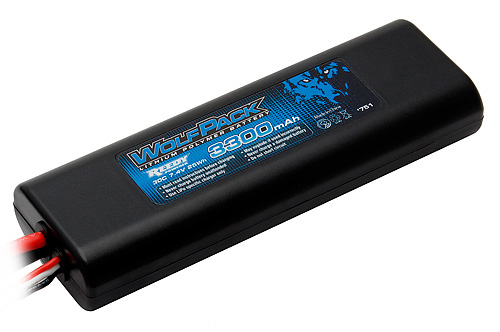
Reedy WolfPack LiPo 7.4V battery
Batteries come in different types.
- LiPo (Lithium-Polymer) batteries have largely replaced the old-style NiMH (Nickel-Metal Hydride) batteries. Make sure your charger will charge your battery type.
- Batteries need the same connector type as the plug on the electronic speed controller (because that's where you plug the battery into). Most of our RTR vehicles use the T-type connector, so be sure to check the connector type you have to make sure you purchase a replacement with the proper connector.
- Batteries come in a range of milli-amp hour (mAh) capacities. The higher the mAh number the more capacity, which translates to longer run times (more time between charges) and higher cost. The higher the voltage, the more power and performance is supplied. However, be sure that the battery will fit your vehicle (some are long, some are short), and that the ESC is compatible with the voltage and type of battery that you have chosen. More about ESCs below.
- Batteries have a voltage rating (like 3.7V, 7.4V, 11.1V, and 14.8V). A higher voltage gives faster acceleration.
- LiPo batteries must be charged and maintained properly. Be sure that you are aware of procedures and guidelines. Become familiar with them.
Battery charger (peak detection charger recommended)
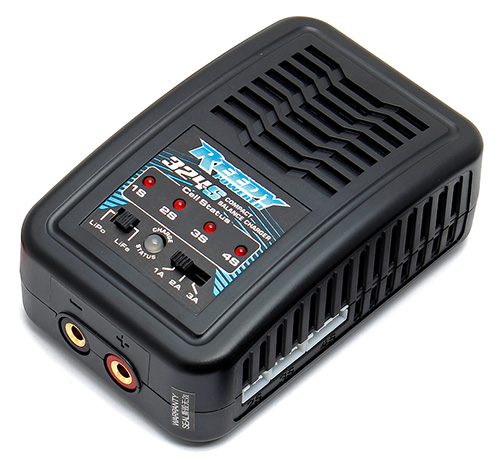
Reedy Compact Balance Charger shown
The NiMH and LiPo batteries need to be recharged. Make sure your charger charges the type of battery you are using. The peak detection feature means that the charger won't dangerously overcharge your battery if it's left on too long. You can set it and forget it.
Electric Motor

Reedy Brushless Motor
Motors vary, depending on their brush type, physical size, and range. Let's take them one by one.
- Motors are divided into two types: brushed or brushless. For the brushless version there is sensored and sensorless. Sensored motors are bit more expensive since the have a sensor that controls how the phases of the brushless motor fire; and in most cases, they also have mechanical timing that can be adjusted for more performance.
- There are several physical sizes of motors: 280 and 370 for 1:14 scale models, 540 for 1:12 and 1:10, 540 or 550 for 1:10 4WD, 866 and 1512 motor for 1:8.
- Motors also have a range number, like 3300kV in brushless motors, or 17 turns in brushed motors (the higher the brushless kV, the faster the RPMs; but the lower the brushed motor turns, the faster the RPMs.) The motor's number must be matched to the electronic speed controller's ability to handle that number. More on this next.
Electronic Speed Control (ESC)

Reedy Blackbox ESC
You need to match the ESC to your motor. In other words, if the motor is labeled 3300kV, then check the ESC for compatibility. If the ESC specs state a "Motor limit" of 2650kV (indicating a range of 0-2650kV), then the 3300kV motor is outside the range of the ESC; pairing them could damage either component. Conversely, if the brush motor ESC is rated 9.0 turns (indicating 9.0 and higher numbers), then an 8.5 is out of range, but a 17-turn will be in range.
- Compare Amp numbers among ESCs: a higher number is better.
- Compare On-resistance among ESCs: a lower number is better.
Radio System
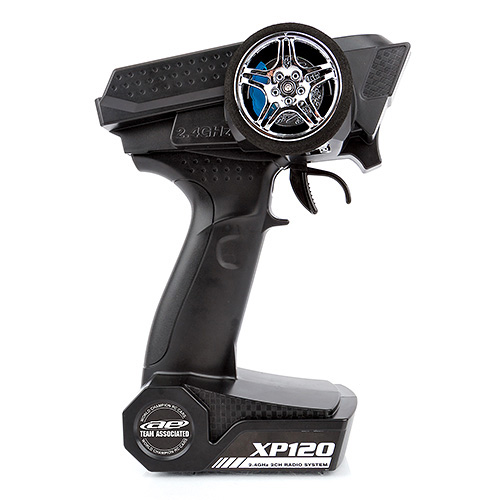
Radio Transmitter
Earlier radio systems relied on matching crystals in the car and transmitter to operate on a secure band. Nowadays we use the 2.4GHz band, which matches up the radio to the car much better and prevents accidentally controlling another car.
Steering Servo
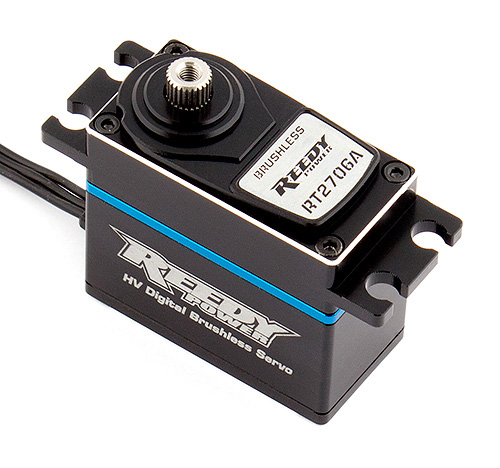
Reedy Brushless Servo
Servos come in high-torque and high-speed varieties. They push/pull the linkages that turn your wheels left and right.
- For 4WD offroad buggy and truck applications, use high-torque servos.
- For 2WD and 4WD onroad cars, use high-speed servos. However, 1:8 scales would benefit with high-torque servos.
Pinion Gear, 48 pitch
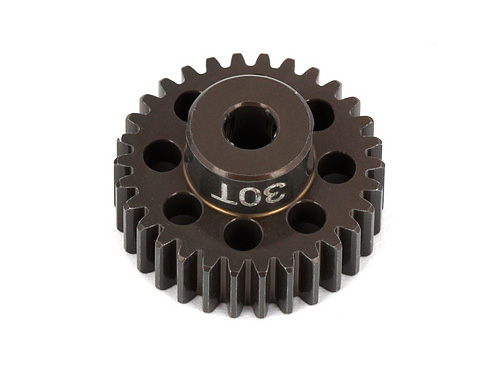
48T Pinion Gear
The pinion gear is attached directly to the electric motor shaft and drives the spur gear.
- The pitch of the pinion gear needs to match up with the spur gear pitch, which, in this case, is specified as "48 pitch." This interplay is called "gearing." Some 1:10 and 1:12 onroad cars come with 64-pitch gears. The other thing to considered is what size motor the gear is meant for. The #1348 pinion pictured is generally used on a 540 size can motor with a 1/8" shaft, while a 550 can and the 1/8 scale 866 can use a 5mm shaft version. Select a pinion that has the correct hole size for the motor shaft and the proper pitch for the spur gear that is on the vehicle.
- You'll need to choose among a tooth-count range of possibilities for pinion gears. ("48T" = 48 teeth. Pinions have more or fewer teeth.) How to choose? Fewer teeth = quicker acceleration and more run time; more teeth = more top speed but less run time. (If you remember, run time is how long you'll be able to run your car before needing to recharge.) You can use this calculator to determine your gearing.
- Check with other racers at the track to get an idea of what gearing to start with. Or download a setup sheet for the vehicle to check out the tooth count racers are using. (A setup sheet is a record of the car settings and components used.) See an example here.
Front and rear tires
Wheel sizes are pretty standardized for buggies and trucks within their scale. Your catalog will tell you what wheels and tires are right for you.
Paint for the clear polycarbonate body
RC car bodies are made of polycarbonate material. The paint should be compatible, or it will destroy the body, peel off, or crack.
CA glue for tires and wheels
When you slip the tires onto the wheels, you'll need to glue them in place. We recommend our #1597 Factory Team Tire Adhesive. It sticks equally well to plastic and fingers, though, so be careful!
Also see the tool section below.
Nitro Vehicles
.21 class "rear exhaust" engine
Some vehicles are made for a rear-exhaust engine while others accept side-exhaust engines.
Radio transmitter

Radio Transmitter
Earlier radio systems relied on matching crystals in the car and transmitter to operate on a secure band. Nowadays we use the 2.4GHz band, which matches up the radio to the car much better and prevents accidentally controlling another car.
Transmitter batteries

Reedy AA Alkaline Batteries shown
Your familiar alkaline AA batteries. Usually about four will power the radio transmitter -- check the manual.
6.0-7.4V receiver battery pack

Reedy LiPo flat battery
You need a small battery pack to power the receiver.
- Either flat or hump style NiMH, LiPo, LiFe battery recommended.
- With LiPo and LiFe, we recommend that you use a voltage regulator or voltage cutoff unit.
Fuel bottle
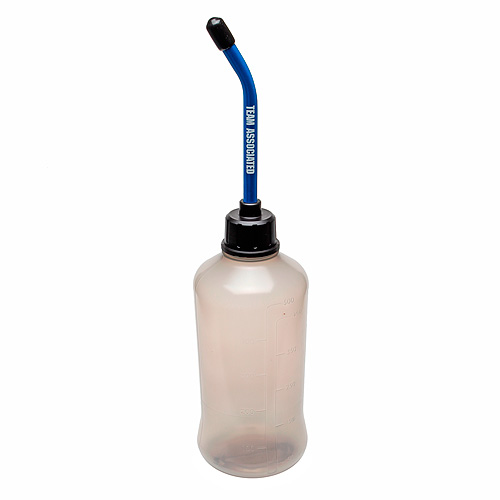
Fuel bottle shown
You pour the model car fuel into this bottle, then keep it on hand for refueling your car. Keep the fuel container capped when not in use.
Thread-locking compound

FT Locking Adhesive
You apply this to screws that are metal to metal and other components that may loosen during racing.
Steering servo

Reedy Brushless Servo
This servo pushes and pulls the linkages that steer the car.
Throttle servo

Reedy Brushless Servo
This servo is the same as a steering servo, but operates on the engine to push/pull linkages that regulate fuel and air flow.
Exhaust system
Engines use a muffler and header pipe. Make sure yours matches your engine, whether rear-exhaust or side-exhaust.
Nitro fuel (30% nitro recommended)
Don't use gasoline from the pump for these engines.
CA (cyanoacrylic) glue
When you mount tires to the wheels, you'll need to glue them in place. We recommend our #1597 Factory Team Tire Adhesive.
Paint for the clear polycarbonate body
RC car bodies are made of polycarbonate material. The paint should be compatible, or it will destroy the body, peel, or crack.
Also see the tool section below.
Don't be overwhelmed by all this information. We recommend getting an RTR for your first purchase, since we've already matched up the components and installed them for you.
Helpful Tools
Tools probably in your toolbox include a flat head screwdriver, nut drivers, pliers, hex drivers, precision metal ruler, hobby knife.
The RC enthusiast has specialized tools at hand to make his work easier. Here are some tools you may not be familiar with.
Turnbuckle Wrench
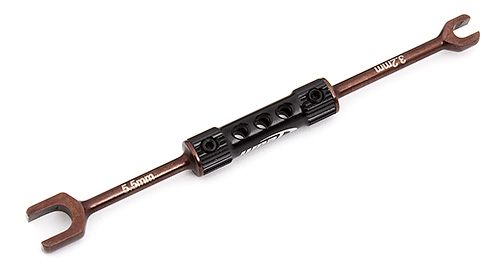
FT Dual Turnbuckle Wrench
Used in place of pliers to adjust the turnbuckles of the car. Make sure your wrench fits your turnbuckles. See #1114 for both 1:10 and 1:8 scales.
Body Reamer
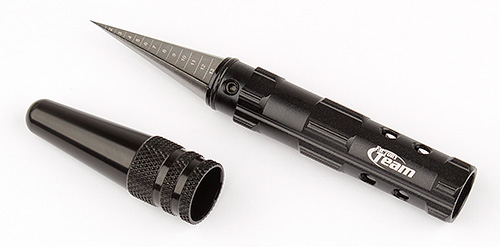
Body Reamer
We need to cut holes in the body to fit it over the body posts that hold it in place. The body reamer is an easy way to make clean-looking holes in the body.
Body Scissors
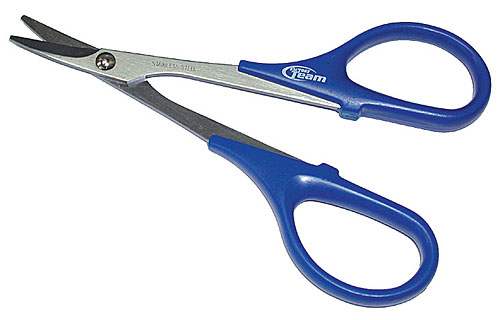
Body Scissors shown
Unpainted bodies need to be cut to shape the body. These scissors will cut through the polycarbonate material better than normal hand scissors. Some racers finish off the edges with sandpaper for a smoother look. See #1737.
Droop Gauge
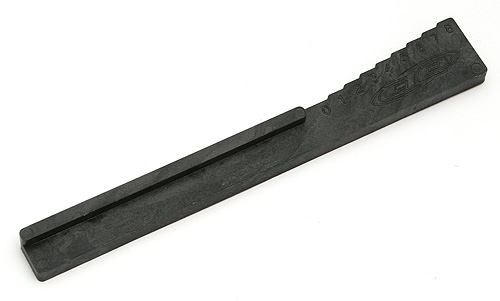
Droop Gauge
Helps set the resting arm "droop" of an onroad touring car. #3987.
Starter Box

Starter Box
The starter box spins a wheel against which you press your engine's flywheel to start the nitro engine. See #1751.
Universal Tire Balancer

Universal Tire Balancer
This helps balance your tires for a smoother ride See #1498 (includes video of operation).>
Wheel Nut Wrench
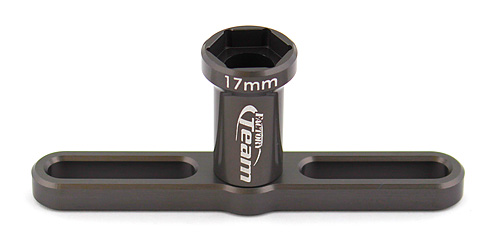
Wheel Nut Wrench
A Wheel Nut Wrench makes quicker work of removing wheels. See #1571.
Ball Cup Wrench
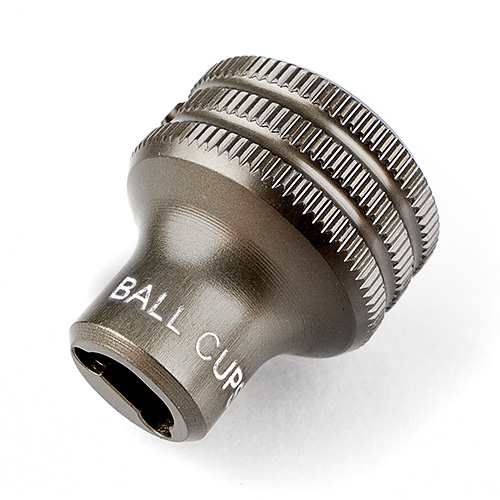
Ball Cup Wrench shown
A Ball Cup Wrench makes quicker work of adding and removing ball cups on turnbuckles. See #1579.
Camber + Track Width Tool
After using the turnbuckle wrench on the camber turnbuckles, which causes the wheel to lean in at the top, you apply the Camber tool to the tire to check the angle.
Shock Shaft Pliers
Shock Shaft Pliers securely grip your shock shaft so it does't get scratched while you screw parts on the threaded end of the shaft.
Ride Height Gauge
A tool to help you set the distance from the chassis to the ground at all four corners of the car.
Soldering Iron
Important if you are going to attach electronics without using plugs. Also need Rosin solder.
Glow Igniter/Starter
This tool gets the glow plugs hot in the engine to make it quicker to start.
Voltage Regulator or Voltage Cutoff Unit
With LiPo and LiFe batteries, we recommend that you use a voltage regulator or voltage cutoff unit.
©2012- Associated Electrics, Inc.
